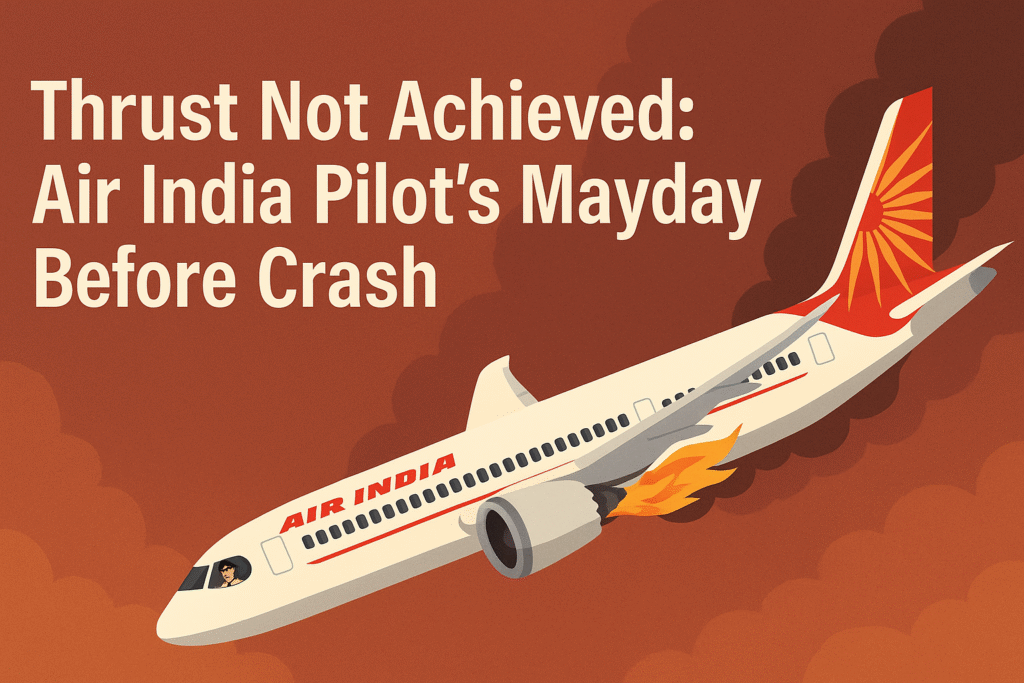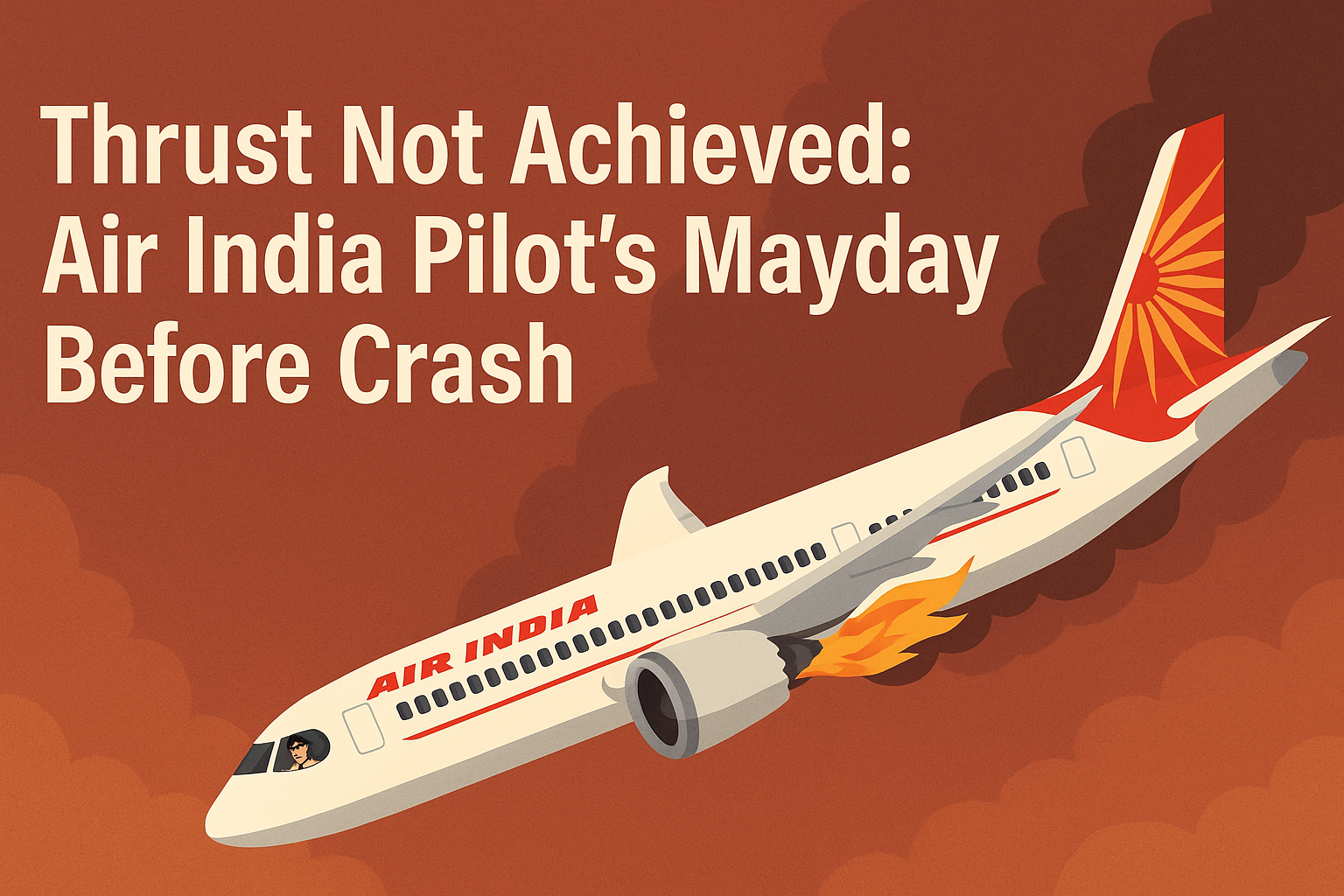
In one of the deadliest aviation disasters in Indian history this Air India Crash is an Air India Boeing 787 Dreamliner crashed minutes after taking off from Ahmedabad’s Sardar Vallabhbhai Patel International Airport en route to London. The crash, which occurred on Thursday afternoon, has left the nation in mourning and raised serious questions about the safety of one of the world’s most advanced aircraft models. The final, chilling distress messages from the cockpit — “Thrust Not Achieved”, “Falling”, and “Mayday” — offer a grim insight into the final moments of Flight AI171.
The Flight That Never Reached Its Destination : The Air India Crash
Flight AI171, a scheduled international service from Ahmedabad to London Gatwick, took off at 1:37 PM carrying 242 people — including 230 passengers, two pilots, and 10 cabin crew members. Within minutes, chaos unfolded mid-air. According to Air Traffic Control (ATC) sources, the pilot reported a series of distress signals: “Thrust Not Achieved”, “falling”, and “Mayday”. These alerts reflected a severe and unexpected failure in the aircraft’s propulsion or lift systems.
Just minutes after these signals, the aircraft crashed into a medical hostel complex in the outskirts of Ahmedabad. The result: 270 confirmed fatalities, including civilians on the ground. The sole survivor is a British national of Indian origin, currently hospitalized and in critical condition.
What Does “Thrust Not Achieved” Mean in Aviation?
The phrase “Thrust Not Achieved” is not just a routine warning — it’s a dire sign of engine or mechanical failure. In commercial aviation, thrust refers to the force that propels an aircraft forward, typically generated by jet engines. When a pilot radios in that “Thrust Not Achieved,” it suggests that one or more engines are not providing the necessary power for ascent or level flight.
This loss of power in Flight AI171 critically impaired the aircraft’s ability to climb or even sustain altitude, leading to a rapid descent and eventual crash. The phrase was reportedly the first of three final transmissions sent by the pilot, followed by “falling” and a desperate “Mayday” — the international distress signal.
Crash Site and Aftermath
The Air India Crash site, a densely populated area housing a medical hostel, was reduced to rubble. Emergency services responded swiftly, but the impact had already claimed dozens of lives on the ground. Among the dead were 29 children, further amplifying the tragedy’s human toll.
Debris from the aircraft was strewn across a 500-meter radius. Witnesses described hearing a loud explosion followed by “pieces falling from the sky.” Firefighters battled blazes for over four hours before the scene was declared under control.
The Aircraft Involved: Boeing 787 Dreamliner
The aircraft involved in the crash was a Boeing 787-8 Dreamliner — a technologically advanced and fuel-efficient wide-body jet. Since its commercial launch in 2011, the Dreamliner has been lauded for its composite fuselage, reduced carbon emissions, and long-haul capabilities. However, the AI171 tragedy marks the first fatal accident involving a Boeing 787 model, triggering global scrutiny.
The aircraft in question had reportedly undergone routine checks just days before the crash, according to sources within Air India. However, the repeated use of the phrase “Thrust Not Achieved” by the pilot has shifted investigative focus toward potential mechanical or engine failures.
Black Box Recovered: The Investigation Begins
Union Civil Aviation Minister Ram Mohan Naidu confirmed that the aircraft’s black box — the flight data recorder and cockpit voice recorder — was recovered 28 hours after the crash. Found near the aircraft’s tail, the device is currently being decoded by the Aircraft Accident Investigation Bureau (AAIB).
Preliminary interpretations are expected to focus on engine performance, fuel flow, thrust output, and system warnings in the final minutes before impact. “The pilot’s repeated use of ‘Thrust Not Achieved’ strongly suggests an issue in the propulsion systems,” a senior official from the AAIB commented.
Government Response and Safety Measures
Following the Air India Crash , the Ministry of Civil Aviation ordered immediate safety checks for all Boeing 787-8 and 787-9 aircraft operated by Air India. The Directorate General of Civil Aviation (DGCA) has mandated enhanced inspections of:
- Fuel systems
- Hydraulic systems
- Engine thrust calibration
- Electrical and flight control systems
Air India, which operates a significant portion of its international fleet with Boeing 787s, is expected to complete this audit by the end of the month.
Family Reactions and Public Outcry
As the nation comes to terms with the disaster, families of the victims have demanded accountability. “How could this happen within minutes of takeoff? If there was a problem with thrust, why wasn’t it caught during pre-flight checks?” questioned a grieving relative at a candlelight vigil in Delhi.
Social media erupted with questions and anger over the condition of aircraft fleets and the responsibilities of both airline operators and aviation regulators. The hashtag #ThrustNotAchieved began trending within hours, symbolizing both technical failure and collective sorrow.
Expert Analysis: Could This Have Been Prevented?
Aviation experts suggest that the phrase “Thrust Not Achieved” might point to several scenarios:
- Engine Flameout: Sudden loss of engine power due to fuel starvation, icing, or mechanical fault.
- Bird Strike: A high-density bird impact causing engine failure immediately after takeoff.
- Sensor Malfunction: Faulty thrust or airflow sensors providing inaccurate data to flight computers.
- Maintenance Oversight: Undetected wear and tear on engine components.
Only a thorough analysis of black box data can confirm the exact cause of Air India Crash . However, early indicators do not point toward pilot error but rather a mechanical or systemic failure that occurred moments after takeoff.
International Repercussions and Industry Response
The International Civil Aviation Organization (ICAO) has reached out to Indian aviation authorities for a comprehensive report. The incident has also raised alarms among other Dreamliner operators, many of whom are conducting their own internal reviews.
Boeing released a brief statement: “We are deeply saddened by the loss of Flight AI171 and are working closely with Air India and Indian authorities to support the investigation. Safety remains our highest priority.”
Conclusion: A Sobering Reminder of Aviation’s Fragility
The Air India crash, underscored by the haunting final message — “Thrust Not Achieved” — has shaken public confidence and industry assumptions about aircraft safety. As the investigation unfolds, all eyes remain on the findings from the black box and the systemic reforms that follow.
For now, the nation grieves not only the 270 lives lost but also the painful realization that even the most modern aircraft can fall victim to sudden and catastrophic failure.

2 thoughts on “Air India crash: ‘Thrust Not Achieved,’ 270 killed”
Comments are closed.